For additional information relating to this article, please contact:
October 29, 2020POLICE REPORTED CRIME STATISTICS, 2019 
Statistics Canada has released the 2019 results for police-reported crime statistics collected under the Uniform Crime Reporting Survey. This report measures incidents of crime, crime rates (per 100,000 population), and crime severity (based on sentencing data) by types of crime.
Canada's crime rate (Criminal Code violations excluding traffic) was 5,874 incidents per 100,000 population. In comparison, Nova Scotia's crime rate for 2019 was 5,255 per 100,000 population. Nova Scotia’s total crime rate was below the national rate for the fifth consecutive year following nearly two decades above the national rate. Halifax's crime rate fell below the provincial rate, with 4,925 incidents per 100,000 population.
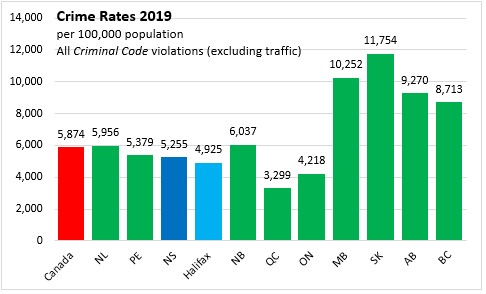
Across Canada, crime rates were higher in Manitoba and Saskatchewan. The lowest crime rates among provinces were in Quebec and Ontario.

Nova Scotia's crime rate (Criminal Code, excluding traffic) increased 3.3% in 2019, though there was a 6.3% decline in Halifax. Nova Scotia's crime rate started to rise in 2017 after six consecutive years of decline; Nova Scotia's crime rate has increased in each of the last three years. Canada's crime rate increased by 6.5% in 2019. This is the fifth consecutive year of increasing crime rates for Canada, following declining rates for the 11 years before 2015. The 2019 national crime rate was back up to levels last observed in 2010. Among provinces, crime rates were only down in Quebec last year. The largest increases in crime rates were reported in Prince Edward Island and British Columbia.

In Nova Scotia' there were 1,414 violent Criminal Code violations per 100,000 residents in 2019, which was above the national rate of 1,276. There were 2,848 property violations per 100,000 residents and 992 other Criminal Code violations. Nationally, there were 3,510 property violations and 1,087 other Criminal Code violations per 100,000 residents.
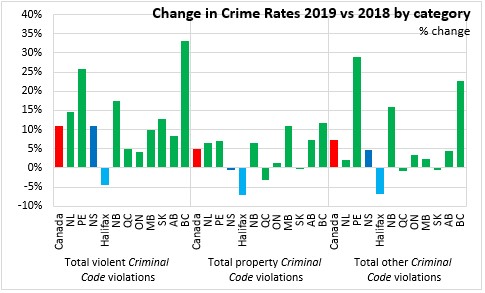
In the last year, the violent crime rate was up 10.9% - both in Nova Scotia and at the national level. The rate of violent crime decreased 4.5% in Halifax. Property crime rates were down 0.6% in Nova Scotia and 7.0% in Halifax while the national property crime rate increased by 4.8%. Other Criminal Code violations were up 4.8% in Nova Scotia, down 6.9% in Halifax and up 7.3% nationally.
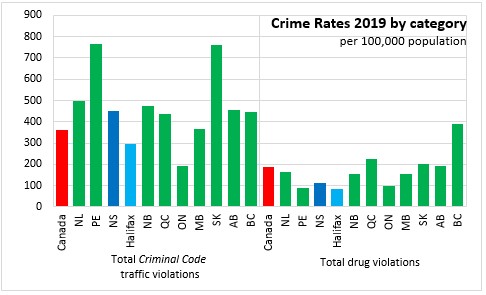
Nova Scotia reported 449 Criminal Code traffic violations per 100,000 residents in 2019, which was above the national average of 364. There were 295 Criminal Code traffic violations per 100,000 residents in Halifax.
Nova Scotia's drug violation rate was 113 per 100,000 residents while Halifax's was 85. The national drug violation rate was 187 per 100,000 residents.

The rate of Criminal Code traffic violations increased by 28.4% in Nova Scotia in 2019 (+9.8% in Halifax), which was faster than the 7.1% increase nationally. The rate of drug violations was down 46.3% (-59.1% in Halifax) in 2019. The rate of drug violations was down 18.6% nationally with declines in every province except British Columbia.
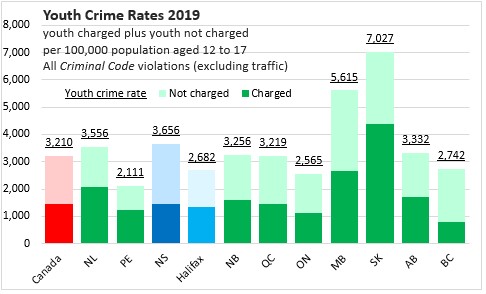
Nova Scotia's youth crime rate in 2019 was 3,656 violations per 100,000 residents aged 12-17, which was higher than the national youth crime rate (3,210). The youth crime rate was lower in Halifax (2,682). Youth crime rates are higher in Manitoba and Saskatchewan. Note the youth crime rates are divided into youth who are charged for a reported crime and youth who are not charged for a reported crime.
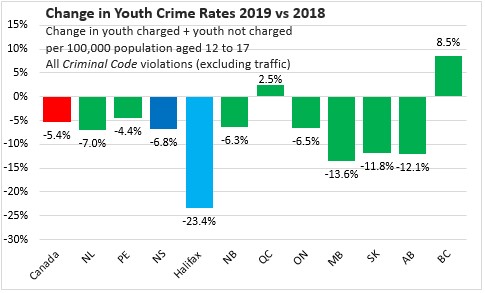
The youth crime rate declined 6.8% in Nova Scotia (-23.4% in Halifax) while the national youth crime rate declined 5.4%. Youth crime rates were down in all provinces except, Quebec and British Columbia.
The overall severity of crime, as measured by the Total Crime Severity Index (CSI), increased 0.8% for Nova Scotia, but declined 9.9% for Halifax in 2019. Nationally, the Total CSI increased 5.1% in 2019, the fifth consecutive year of increase. The severity of violent crime increased 4.0% in Nova Scotia, though it was down 13.2% for Halifax. National violent crime severity increased 7.3% in 2019. Non-violent crime severity was down 0.7% in Nova Scotia, 7.9% in Halifax and up 4.1% nationally.
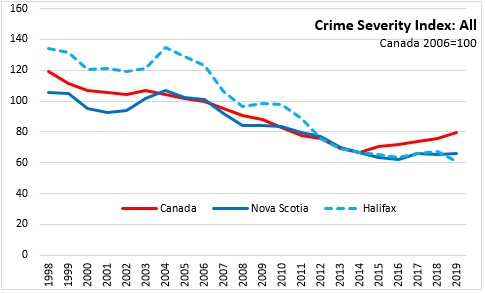
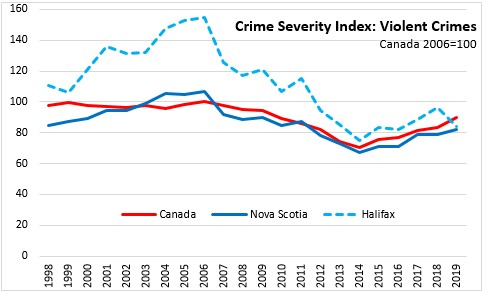

NOTE: on January 1, 2018, Statistics Canada, in collaboration with police, changed the definition of “founded” criminal incidents. With the new definition, there is the potential that police will classify more incidents as founded.
Source: Statistics Canada. Table 35-10-0026-01 Crime severity index and weighted clearance rates, Canada, provinces, territories and Census Metropolitan Areas, Table 35-10-0177-01 Incident-based crime statistics, by detailed violations, Canada, provinces, territories and Census Metropolitan Areas